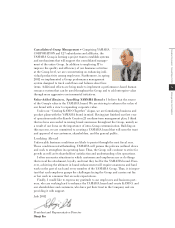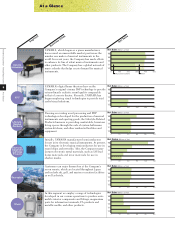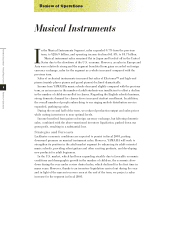Yamaha 2002 Annual Report Download - page 17
Download and view the complete annual report
Please find page 17 of the 2002 Yamaha annual report below. You can navigate through the pages in the report by either clicking on the pages listed below, or by using the keyword search tool below to find specific information within the annual report.
Sales in this segment amounted to ¥36.6 billion, a 15.3% decrease compared with
the previous term, while operating income totaled ¥4.4 billion, a 34.6% decrease.
In semiconductors, despite a dramatic increase in sales of mobile phone
sound chips, sales of sound chips for PCs and video games declined, resulting
in an overall sales decrease. In Japan, growth in sales of mobile phone sound chips
slowed because high mobile phone market penetration rates put downward pressure
on mobile phone sales and mobile phone retailers took steps to liquidate excess
inventories, thus delaying the sale of new mobile phone products. However, shipments
to South Korea and other countries increased.
In electronic metals, although there were signs of a recovery in the demand for
semiconductor lead frame materials during the second half of the term, demand for
semiconductors was flat, and, on the whole, lackluster conditions prevailed throughout
the term. As a result, sales fell by half compared with the previous term.
As problems with product quality translated into lower manufacturing output, sales
of invar materials, which we began producing in the summer of fiscal 2002 for use in
large-screen desktop-computer shadow masks, were less than expected. Due to the
above factors, segment sales fell from the previous term.
In addition, although we launched a mass-production thermoelectric module business
during the term, the fiber-optic glut in the United States forced us to reduce manufac-
turing output to negligible levels.
Strategies and Forecasts
In fiscal 2003, we expect to accelerate the production of mobile phone sound chips
to meet growing demand for such products in Asia and Europe as well as the needs
of mobile phone manufacturers in Japan, who will begin selling mobile phones with
40-note polyphony sound chips. To boost sales and income compared with the term
under review, YAMAHA plans to step up the production of lead frame materials in
anticipation of renewed demand in the electronic metals and semiconductor markets
and accelerate the production of invar materials that are free from the quality
problems mentioned above.
Yamaha Corporation Annual Report 2002 Review of Operations
15
Electronic Equipment
and Metal Products
Shadow Masks 왘Nickel alloy steel is used to
make invar materials for shadow masks for CRTs.
Sound Chip YMU 762 왘
These 40-note polyphony
sound chips include built-in
ADPCM (Adaptive Differential
Pulse Code Modulation)
sound generators that can
play back human voices
and other recorded sounds.
Lead Frames 왘Lead frames for
semiconductors
























